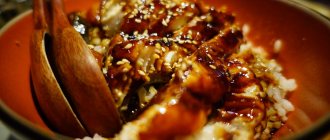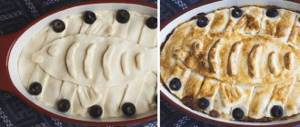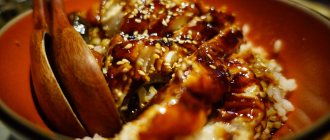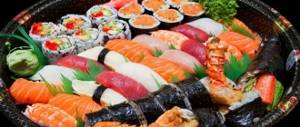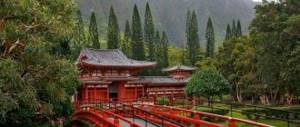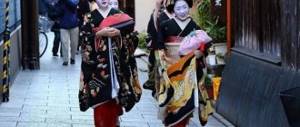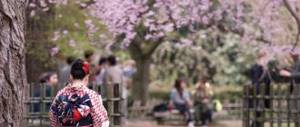Japanese cuisine is both beautiful and mysterious, attractive and incomprehensible - like the whole Land of the Rising Sun. The most famous oriental dishes in our country are sushi, sashimi and rolls. However, the cuisine of the Far East is not limited to them only. The Japanese cook delicious noodles and make original dishes from seafood and different types of meat.
Japanese cuisine is delicious and beautiful
Features of Japanese cuisine
Japanese food is not just food for the body, but a delight for the eyes. Cuisine of the Land of the Rising Sun:
- requires a reverent attitude to form and color;
- includes the concept of seasonality and appropriateness to weather and period of year;
- puts the natural taste and appearance of ingredients at the center;
- served in small portions and small pieces that can be eaten with chopsticks or hands;
- necessarily includes green tea accompanying the main meal.
Traditional dishes are prepared from fresh ingredients, avoiding food that has been stored for a long time (with the exception of sauces and rice). Many recipes include seafood.
An important feature of Far Eastern cuisine is the association of food and season. Each season corresponds to a set of delicacies. Taking this association into account is just as important as using only fresh produce. For example, in autumn, carrots are cut into the shape of maple leaves for soup, and spring desserts are decorated with sakura flowers.
Japanese dishes cannot be called heavy. Food is served in small portions. Most traditional foods are low-calorie. However, there is no threat of hunger: a wide variety of dishes and snacks are served at the table at the same time, so everyone will leave full. In former times, an aristocratic meal included up to 20 courses, and the classic division into hot, cold, soup, main course, and dessert was not used. The Japanese distinguish the beginning, middle and end of a meal. The order of consumption is at the discretion of the diner.
Japanese food is tasty and dietary
Personal opinion
Larisa Dolina, singer:
– I love to cook and I try to ensure that the food I make is, above all, healthy. Most often these are fish dishes. For example, a salad of fresh red fish. Boil fish fillet, 200 grams, separate it from the bones and chop it. Add a cup of boiled rice. You peel a green apple and an onion, then chop everything finely and mix. Season with light mayonnaise. You can use olives and herbs for decoration.
Rice dishes
The most famous recipes in our country for classic Japanese cuisine are with rice. On average, a Japanese eats rice 2-3 times a day; often without seasoning, in small portions. It is believed that such food maintains health. In addition to main dishes, rice is used to prepare alcoholic drinks - beer, sake, sethu. Rice sake aged for decades reaches a strength of 18 degrees and tastes similar to sherry. Sethu is like vodka.
Onigiri
The national rice dish is onigiri (rice balls with filling). These are convenient portions, quickly fill you up and are suitable as a snack. Since the bulk of the ball is rice, each serving contains a lot of carbohydrates. Thanks to this, onigiri is a popular snack that is taken for lunch at work, school, or on a trip. Anyone can try onigiri - portioned balls are sold in convenience stores on the prepared food shelves. You can eat them on the go - the portions are packed in special bags that open in one motion. Preparing onigiri at home takes a few minutes and is accessible even to inexperienced cooks.
There is no single generally accepted recipe. Rice balls are not made with sweet fillings, but this is where the restrictions are exhausted. Often, portions are supplemented with vegetables, fish, and meat. You can prepare the filling specially or use leftovers from what you made earlier - a half-eaten omelette, yesterday's salad, meat from soup.
Cooking process:
- boil short grain rice;
- make a ball;
- wrap with a strip of nori;
- serve with soy sauce.
Japan's national rice dish is made from unleavened rice. Portion size is at the discretion of the cook. The average weight of a ball is 80 g. You can sculpt onigiri in the shape of triangles, squares, balls and even cartoon characters. In the photo, the menus of famous restaurants often feature exquisite, impeccable classic onigiri.
Onigiri
Sushi
The first step towards the emergence of the modern version was the invention of fish fermentation. In those days, sushi was made from fermented rice and a piece of fish. A strip of nori was added for decoration. Literally, the word “sushi” is translated as “rice with vinegar”, but is used to refer to a small (comparable to the size of a finger) piece of fish on rice. The most common subtype is nigiri, prepared with raw fish or shellfish. The serving size is such that it can be eaten in one sitting.
Sushi is the country's most popular dish outside Japan. They are served with wasabi and soy sauce, and pickled ginger is eaten between servings, which renews the sensitivity of the taste buds.
Over the past centuries, sushi has evolved from everyday food into masterpieces of gastronomic excellence. The serving style depends on the ingredients, the characteristics of the restaurant and the principle of the meal. Simple presentation and the ability to follow Japanese minimalism are highly valued.
Sushi is distinguished:
- chirashi in the shape of a rice box with fish slices;
- inari with fried tofu, mirin and sake;
- maki with fish filling, wrapped in seaweed (rolls);
- nigiri or edomae sushi, which are the most common;
- temaki in the shape of a nori cone with rice filling and stuffing with vegetables and fish.
Poppies are divided into:
- shikai (in the form of strict figures, with complex layers of ingredients);
- uramaki (rolls with rice facing out, decorated with sesame seeds and caviar);
- hosomaki (simple rolls);
- futomaki (large rolls filled with several ingredients).
Sushi is served with any meal - breakfast, lunch, dinner.
Sushi
Breakfast in the hotel
For breakfast (buffet at the hotel) we were offered scrambled eggs, sausages, rice and misu soup every day. The remaining ingredients varied: boiled vegetables, sweet potatoes, buckwheat noodles, green salad and fresh tomatoes, various pickles. There were also fruits (pineapple, orange and grapefruit slices), apple and orange juice, coffee and tea.
Breakfast in the hotel. Coffee, miso soup, orange juice, omelette, sausages, noodles and vegetables
Dining room at the hotel
A hearty breakfast at the hotel is the key to energy for the whole day
Another variation on the breakfast theme
Seafood
Japanese chefs can cook thousands of varieties of seafood. The classic version is light frying, stewing, steaming. Many ingredients are used raw. What type of raw fish to serve is determined based on the season. The advantage of tasty food is rapid absorption and saturation with useful microelements. To disinfect fish, it is treated with vinegar.
Occasionally, seafood is consumed not just raw, but alive. They are called odori dishes. This is how squid and perch are served.
Sashimi
Sashimi
Sashimi is rightfully considered the most popular in the Land of the Rising Sun. Sashimi is sliced raw fish. Shiso and daikon are served as appetizers. Sashimi is often served with a portion of rice.
There are several styles of sashimi. More often they are prepared as hira-zukuri - from rectangular pieces. Ito-zukuri is a thin slicing style. Kakku-zukuri is the most complex option, requiring translucent cutting for subsequent composition of picturesque patterns.
A good tone in Japanese cuisine is minimalism in appearance and taste. In order not to lose the originality of the fish, sashimi is served with soy sauce and wasabi.
Yakizakana
This is the name of a traditional fish dish cooked over an open fire. At home, yakizakana is made on the grill. It is especially appreciated for its delicious crunch. National food is served in ryokans. Most often, yakizakana is part of breakfast, but sometimes it is served at other times of the day. For cooking, horse mackerel, saury, salmon, and mackerel are used.
Yakizakana
Fugu
A specific dish of Japanese cuisine is fugusashimi. The delicacy is expensive, tasty and very beautiful. It is prepared from pufferfish, the meat of which has an unusual pearlescent color. The slices are served raw or fried. Traditional layout - petals in a circle. Suitable sauces include vinegar ponzu, asatsuki, grated daikon, and red pepper. Fugusashimi must be accompanied by:
- chawan – pufferfish fins charred from frying on a grill, placed in sake for a couple of minutes;
- soup made from boiled pufferfish, rice and eggs (fugu-zosui).
Every year the Japanese consume about 1,500 tons of fish. Scientists have proven that fugu appeared in the diet of the inhabitants of the Land of the Rising Sun several thousand years before the beginning of our era.
The peculiarity of the fish is that it contains dangerous tetrodotoxin in the liver, caviar and muscles. Just 1 mg of the compound is lethal to an adult; fish contains up to 40 mg. There is no effective antidote. To prepare pufferfish, chefs undergo special training, after which they receive a license. The price in a certified restaurant is up to $750 per kilogram. The best is considered to be fugusashimi, which contains a microscopic dose of tetrodotoxin, creating a feeling of mild euphoria.
Puffer fish
FISH DELIGHTS
Unagi kabayaki . This is eel (unagi in Japanese) coated in sauce and grilled over charcoal. The eel pulp is very tender, sweetish in taste, rich in protein, calcium and vitamins. It is believed that unagi helps with fatigue and gives a lot of energy.
This dish is also a great example of the minimalism of Japanese cuisine: striving to use fresh and healthy ingredients. This dish has interesting Japanese history from the Edo period (1603-1867). During the Edo period, for some reason in Japan, it was believed that in order to survive in the hot summer period, you must eat foods that begin with the letter “u”.
Photo – pixabay.com, unless otherwise noted
Just at this time, one enterprising Japanese Hiragi Gennai opened a restaurant and began preparing eel according to his own recipe. As a result, the restaurant of the resourceful “chef” was so crowded that after this a tradition and sign began - eating unagi for a happy summer. Doyonohi, the day of unagi, is still celebrated today. This day is calculated according to the Japanese calendar and usually falls in July-August - the period of the hottest time and high humidity.
In some regions, unagi is steamed rather than fried. You can enjoy unagi either as a separate dish or with rice (the second option is more popular). Nagoya has a unique way of eating unagi known as hitsumabushi, where the tea is poured over rice and then eaten.
Chawan-mushi . A dish in which various ingredients such as chicken, white fish, shrimp, fish paste and gingko nuts are added to a mixture of eggs and dashi in a bowl (chawan) and steamed. You can order chawan mushi in traditional Japanese restaurants. In appearance and texture, the dish is similar to custard, but has an unusual taste.
Meat dishes
Although the Land of the Rising Sun is known primarily for its fish cuisine, meat is a special pride of Asian chefs. The most popular:
- sukiyaki;
- shabu-shabu;
- nabe.
Sukiyaki has been known in Japan for a century and a half. Previously, it was cooked over a fire, now they use special braziers and vats.
To prepare nabe, the meat is cut into thin slices and stewed in a sauce with miso, onions and vegetables. Sake is often added. It is customary to serve raw eggs and soy with meat.
There is sukiyaki-nabe. It uses marbled meat, tofu, vegetables, noodles, and eggs. During the cooking process, improve the sauce for sukiyaki-nabe with spices to taste.
Katsudon, a pork cutlet, is popular. It is served with egg filling.
Kobu-gyu is the main meat dish in the Land of the Rising Sun. It is prepared on a special roaster in front of the guests from marbled meat of the highest quality. The peculiarity of kobu-gyu is its delicate, melting taste. For cooking, only the meat of young bulls raised in Kobe is used. The livestock farming process is strictly controlled: the bulls are given the best grain and clean water, and immaculate meadows are used as pastures. The animals' diet includes beer, and daily procedures include electric massage and relaxation in cradles listening to classical music.
Katsudon - pork cutlet
Yakitori
Japanese yakotori kebabs are famous all over the world. They are made from chicken and served with vegetables. Most often, yakitori is made on bamboo skewers. It is not necessary to remove the entrails from the bird for cooking. Yakitori is an inexpensive beer snack served at most izakaya and bento shops.
In some areas of the country (Kyushu, Hokkaido), yakitori is called kebabs with seafood and meat. Kebabs made from a mixture of chicken, meat and seafood are popular.
Yakitori
Niku-zaga
Niku-zaka is a simple, everyday dish common throughout the Land of the Rising Sun. Its taste is called “mother” or ofukuro no aji. Niku-jaga is almost identical to the classic potato stew with meat. The recipe appeared at the end of the last century. It is believed that the idea of cooking potato stew first came to the minds of the admirals of the Imperial Navy, who carried out the order of Togo Heihachiro, who wanted a dish similar to the treat at a British Royal Navy dinner party to be constantly served at his table.
The Kure city government does not agree with this story. Representatives of the municipality are confident that niku-zaga is an original invention of chefs from this town.
Niku-zaga is made from potatoes and a small amount of meat. To prepare the beef, cut it thinly. The finished stew is served with white rice and miso. In some regions, beef is replaced with pork.
Niku-zaga
Meat
Actually, meat dishes are not in the Japanese tradition. Livestock was never kept here due to the lack of pastures, and hunting wild animals to provide food is contrary to the philosophy of Buddhism. Therefore, the Japanese discovered meat only in the 19th century, with the arrival of Europeans in the country. Even today, the average Japanese eats an order of magnitude less meat than a European.
However, the Japanese still have their own traditional meat dish. This is the so-called “marbled meat”. This delicacy is obtained by feeding young bulls in a special way. The calves are practically not allowed out of the stall and are generously fed with beer. After such a life, bull meat becomes especially tender and soft.
Noodles
Japanese noodles are a special product, unlike European pasta. Rice, buckwheat, and wheat are used for cooking. Ready meals are served cold or hot. Thus, soba is often made cold and consumed with soy sauce, and wheat udon is served hot. The broth in which the pasta was cooked is served separately and consumed with soy sauce.
Ramen
Ramen is a healthy and tasty Asian dish that has spread throughout the world. Main ingredients:
- noodles;
- seaweed;
- bouillon;
- vegetables;
- seasonings
The noodles are combined with broth and other ingredients and served. Often a boiled egg, cut into two slices, is added to ramen.
There is no single recipe for making ramen. The Japanese themselves divide the options by region: Hakata, Kitakata, Wakayama, Onomichi. A special variety is spicy kimchi ramen.
There are rules and order for eating ramen. First, large ingredients are eaten (sticks are used). The noodles must be sucked in, making specific squelching sounds. The broth is drunk last.
Delicious ramen
Soba
Soba is a traditional product made from buckwheat flour (often with the addition of wheat for plasticity). A special knife is used to cut the dough; the finished strips are boiled. There are varieties of soba:
- cha (with green powdered tea);
- hagi (with seaweed);
- inaka (thick noodles made from whole buckwheat grains);
- juwari (made from pure buckwheat flour);
- Sarasina (light noodles made from peeled buckwheat);
- ni-hachi (20% wheat and has symbolic meaning).
Historians believe that buckwheat has been known to the Japanese since ancient times. In 1254, the monk Dome wrote a mocking waka about Greek, and the Ruijusandaikyaku collection of laws required peasants to grow this crop. Buckwheat noodles gained popularity during the Tokugawa period. Edo is filled with cheap buckwheat establishments catering to those for whom white rice is too expensive. It turned out that consuming soba reduces the risk of beriberi.
Soba is served cold in summer and hot in winter. The chilled one is decorated with seaweed and seasoned with soba tsuyu sauce made from dashi, soy sauce and mirin. It is served hot with diluted tsuyu, often with vegetables, seaweed, batter, and shrimp.
Particularly interesting is the “moon watching dog” tsukimi. For it they use cheese and egg. The yolk is associated with the full moon, the white represents clouds. Tsukimi-soba is served during the season of enjoying the moon.
On New Year's Eve, toshikoshi is prepared - soba, symbolizing best wishes. When moving house, neighbors are given hikkoshi.
Buckwheat soba noodles
Udon
Udon is an essential, common, affordable Japanese food. It is available in most inexpensive cafes and restaurants and is known in various forms. The noodles are made from wheat flour with the addition of mineral water and salt. The culture of eating udon was adopted from China in the 14th century.
In the eastern regions of Japan, udon is served with a dark brown broth containing soy sauce. In the western part, light soy broth is popular.
Family restaurant "Fami-Resu" (ファミレス)
Fami-Resu (ファミレス), which means "family restaurant", comes from the abbr. English - “Family restaurant”.
If Izakaya (previous description above) is about selling alcohol, and food is secondary, then Famiresu is the complete opposite. There is no alcohol or tobacco in Famiresu (smoking is prohibited). From the etymology of the word, one can guess that the main audience of Fami-Resu is families. A visit to such a place for 1 person will cost approximately 700 ($7) to 2000 yen ($20), taking into account the average Japanese appetite. 
Soybeans
Although soy is not considered a traditional Japanese ingredient, it has long taken the country by storm. Distribution began from Kyushu, Honshu in the 18th-19th centuries. The product was brought from Korea and they learned how to prepare all kinds of dishes from it. The sauce and cottage cheese (tofu) have gained particular popularity. There is soy cheese that tastes like Philadelphia, and even soy sushi.
Miso paste is made from soybeans - a fermented product, on the basis of which the broth of the same name is made.
A popular soy product is fuju, the cooled, dried foam skimmed from boiling soy milk. Fuchsia is sometimes called soy asparagus.
Miso paste
Tofu
Tofu bean curd is a protein product made from soybeans with a neutral taste. This is an almost universal ingredient. It is believed that it was invented by accident - sea water got into a dish with crushed soybeans. Tofu was probably first made in the 2nd century BC. In Japan, bean curd has been known since the 8th century. In the second half of the last century, it penetrated into Western countries.
In Okinawa, tofu is produced with seawater rich in magnesium and calcium. It is called shima-dofu (island tofu). In the rest of Japan, curd is made by heating and filtering soy milk using magnesium chloride, calcium sulfate, or citric acid. The curdled cottage cheese is pressed and packaged. Raw tofu can be stored in a vacuum for weeks, and in a container with water for a week (you need to change the water every 1-2 days).
There are different types of tofu:
- classical;
- western (thicker than standard);
- Asian (with a high percentage of water in the composition);
- silk (contains a lot of water, suitable for desserts);
- smelly (popular in Shanghai).
Seasonings, nuts, and red bell peppers are suitable additions to tofu. The finished product is used for main courses and desserts.
Soy tofu
Ramen
This is a soup based on broth and wheat noodles. There are many variations of ramen. It is assembled by adding different ingredients to the base. It can be seaweed, egg, meat, vegetables, onions, shiitake mushrooms, tree mushrooms, bamboo shoots, pickles, bean sprouts. The broth can be fish, chicken, beef or pork. When cooking, roots, vegetables and seasonings are added to it.
The soup turns out to be very nutritious and tasty, and most importantly it’s quick to prepare: the broth can be prepared in advance and frozen, and before eating, reheat and add everything else.
There are several types of this dish; each locality prepares its own version. They are also distinguished by the type of broth:
- Shoyu
is chicken, less often fish or beef broth with the addition of soy sauce. It is made transparent and not very greasy. This is the oldest type of broth for this dish. - Shio
- with added salt. Brewed with chicken, fish, vegetables and seaweed. The ratio of these ingredients depends on the wishes of the cook. - Miso
– As the name suggests, miso paste is added to this broth. It became popular relatively recently, in the 20th century. The base for it is cooked in the same way as for the first two types. Sometimes this broth is made with pork bones, but so that it is not too fatty. - Curry
is the thickest and richest of all. Cooked on pork bones with the addition of curry seasoning, very loved by the Japanese. It is believed that soup based on this broth is most loved by men because it is very filling.
Beans
In Japanese cuisine, beans are not only a popular legume with which to make main dishes, but also an ingredient for the sweet azuki paste (anko). To make anko, beans are boiled with honey or sugar.
There are subspecies:
- tsubu (with whole beans);
- tsubushi (mashed boiled beans);
- koshi (filtered tsubushi);
- sarasi (dried and reconstituted paste).
The paste can be made from any color of bean. For chestnut there is the term “kurian”, for white - “shiroan”.
Popular dishes with anko:
- ammitsu (dessert with agar-agar and fruit);
- an-pan (baked goods);
- dango (rice balls with an paste);
- daufuku (mochi with anko);
- dorayaki (anko sponge cake);
- taiyaki (anko cookies);
- ekan (jelly with paste);
- ankoyaki (grilled pasta);
- shiruko (pasta soup);
- manju (steamed paste cakes).
Bean paste is not just food, but an important element of Japanese culture.
Taiyaki
Tempura
The name of this dish came into the Japanese language thanks to Portuguese missionaries. They called the word “tempura” fast days on which they were allowed to eat seafood and fish.
Tempura is a variety of foods fried in batter. Shrimp, vegetables, fruits, fish, sometimes even meat. Frying is considered ideal when the batter is ready and the filling is almost not heated.
Soups
Classic Japanese soups are simple, minimalistic dishes with plenty of clear broth. Etiquette prescribes the sequence of consumption: in some cases, the broth is drunk first; for other dishes, the order is the opposite.
There is a division:
- simple soups (daily dishes);
- suimono (ceremonial dishes for special occasions);
- mushi (creamy, complex soups popular in restaurants).
Often soup is served for breakfast, lunch and dinner. Traditional dishes include seaweed, bamboo shoots, seafood, daikon, soybean paste, and dashi broth.
Suimono
Suimono is a delicate traditional soup. This is a festive and ceremonial dish with a mild taste and discreet aroma. Suimono contains shrimp, algae, citrus fruits, spices and fish chips. It’s not easy to make this soup at home; Even in Japan they prefer to order it in restaurants rather than making it themselves. Lime slices and boiled sweet carrots are added to suimono.
The soup is served in a bowl with a stand. According to the rules, first put all the ingredients in a bowl, then strain and heat the broth to 75 degrees, only then pour it into the rest of the ingredients. The finished dish is warm, liquid and flavorful.
Suimono
Misoshiru (Miso soup)
Misoshiru is a soup made with miso paste and minor ingredients. For the broth, be sure to use dashi paste. Traditionally, the composition depends on the season and includes products with a sharp and neutral taste. The rule is to combine floating and sinking components: for example, algae and potatoes.
Misoshiru, along with white rice, is a classic breakfast dish. For a long time, such soup was served both at the table of the aristocracy and in the poorest peasant hut.
A variety of misoshiru is wappani. It is common in Awashimaura (Niigata). The soup is prepared in a cedar container heated on stones.
Puffer fish
Fugu is very poisonous. The poison contained in one fish can poison about 30 people. The fugu's venom paralyzes and then death occurs.
There is currently no antidote. If this fish is cooked correctly, it becomes harmless. In order to have the right to cook fugu, Japanese chefs need to undergo special training and obtain a license. Despite this, cases of poisoning still occur sometimes.
The most skilled chefs can cook fugu so that there is such an amount of poison left in it that the person who eats it experiences a slight feeling of euphoria. Although eating this expensive delicacy is like playing Russian roulette, fugu fish is very popular in Japan.
Features of nutrition in Shintoism - why do the Japanese eat with chopsticks?
The philosophy of Shintoism , the religion of the Japanese people , speaks of the divine origin of everything that is on earth. Therefore, every object, plant or living organism has a special significance in the overall harmony of man with nature.
The first mention of sticks was recorded 15 centuries ago. Noble people used them for eating. The commoners continued to eat with their hands.
Confucius, being a vegetarian himself, approved the use of wooden chopsticks for eating. He once said that we should not have knives and cutting objects at the table that remind us of edged weapons and the bloody battles carried out with their help.
Yakitori
One day we wandered into a yakitori restaurant for dinner. The name of the Moscow restaurant chain, where you can order sushi and rolls for delivery, is completely untrue. Yakitori is actually a dish made from pieces of fried chicken. This is exactly how the word is translated. There are no non-chicken dishes in the yakitori cafe. And there's definitely no sushi.
It turned out to be a colorful place. My husband compared it to the pubs on the outskirts of the galaxy from Star Wars. Smoky and very noisy. Everyone screams to hear each other and laughs at the top of their lungs. This is how the Japanese relieve stress after a working day. The tables are almost exclusively men.
There were no free drinks, but they did bring a plate of salad with curry sauce as an aperitif. We ordered two chicken options and a beer; we were given mugs half filled with ice and, for some reason, water, and bottles of beer. It turned out to be a good thing: beer doesn’t disappear so quickly. 0.33 was enough for the whole dinner.
The skewers are made from different cuts of chicken. For example, one from the central pectoral cartilage only. The other is made of skin, presumably from the neck. One more from the liver and only two from plain meat, gray. The breasts are fried separately; we did not order them.
There are almost no vegetable side dishes; all salad options are with chicken. So we settled for the aperitif plate.
Chicken skewers at a yakitori restaurant
Automatic cafe
There are cafes offering takeaway food. You place an order through a machine, wait 10 minutes and receive a neatly packaged hot dinner at a very affordable price. Not particularly tasty, but satisfying.
There are several seats to eat in the cafe itself. It works on the principle of self-service.
The selection process requires some effort
Without pictures, using such a machine would be completely impossible for us
Ramen with seaweed and tempura with rice
